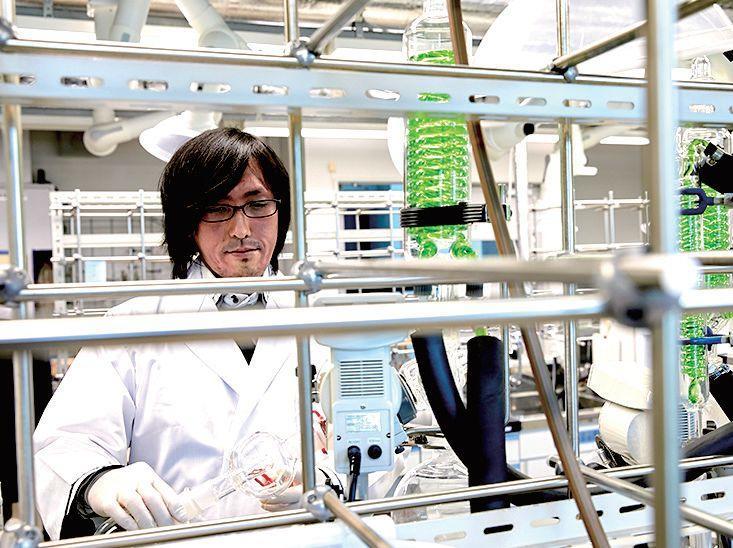- TOP
- Cutting-edge Research and Social Contribution
- Cutting-edge Research
- Constructing systems realizing new photofunctionality by hybridizing ionic nanospheres and molecule-based materials

Constructing systems realizing new photofunctionality by hybridizing ionic nanospheres and molecule-based materials

ITO Akitaka
- Specialized field
Photochemistry, Coordination Chemistry, Analytical Chemistry, Physical Chemistry
All around us. There are many materials which appear or glow with color by absorbing or emitting visible light. The field of photochemistry elucidates such interactions between light and material(s). On the basis of a better understanding of the light absorption/emission, the reactions following the light absorption, and controlling photofunctionality, we can likely contribute to the realization of energy-saving light-emitting devices, and highly efficient light-energy conversion systems.
Associate Professor Ito has achieved numerous results in his efforts to develop new functional materials, evaluate their properties, and elucidate their reaction behaviors. These new light-absorbing and -emitting materials based on molecules and their hybrids possess the characteristic of being visible.
Developing photofunctional materials that respond to various environments
A phenomenon called "intramolecular charge transfer" occurs in some materials. This phenomenon largely changes the spatial distribution of electrons in a material upon the light absorption. According to Assoc. Prof. Ito, "Materials exhibiting intramolecular charge transfer are quite fascinating because their photofunctionality varies greatly depending on any number of factors." These materials are expected to be applied in electronics like OLEDs, and in photochemical devices which transform light energy into electrical or chemical energy, such as dye-sensitized solar cells or artificial photosynthesis systems.
By focusing on this phenomenon of intramolecular charge transfer, Assoc. Prof. Ito has created photofunctional materials with various frameworks and structures. He has not only varied their properties such as emission color, but also elucidated the mechanisms which produce such differences by exploiting methods based on classical electron transfer theory. The unique feature of Assoc. Prof. Ito's research is that he systematically synthesizes various classes of materials including organic, organometallic and coordination compounds based on precise molecular design, and establishes techniques for fine control of photofunctionality thorough understanding of those materials.
Chemistry is generally seen as a field treating invisible things like atoms, molecules, and ions. However, changes in absorption or emission of light, which are targeted by photochemistry, can be detected with high sensitivity and be directly observed by our eyes, and thus, they are being increasingly used as tools to detect chemicals and environments. Taking advantage of these characteristics of light, Assoc. Prof. Ito has worked to develop "environment-responsive compounds" that vary their light absorption or emission behavior in respond to the surrounding environment such as temperature, polarity, or the presence of coexisting materials.
"Through appropriate design, it is possible to control the properties of molecule-based materials: not only which wavelength of light is absorbed or emitted, but also what kind of environment they respond to. We have succeeded in changing emission colors by understanding the properties of each molecule and designing the chemical structure precisely. Furthermore, I believe that we can also develop new photofunctionality by utilizing the effects of the surrounding environment on molecule-based materials."

Achieving enhanced photoinduced reactions by a simple technique using an ionic nanosphere
Owing to the recent threatened energy depletion, there are high expectations for photochemistry in various fields. Artificial photosynthesis, which drives chemical reactions using light energy, is one such example. In the artificial photosynthesis systems, water is split into molecular hydrogen and oxygen, or carbon dioxide is converted to useful chemicals by employing the phenomenon of electron transfer after the light absorption by a photosensitizer (dye) followed by generating a high-energy excited state. These reactions are triggered by a spatial separation of negative and positive charges. To improve the functionality of the system, it is important to improve efficiency of each primary reaction, i.e., energy and electron transfer driven by light absorption. Assoc. Prof. Ito says: "By looking at these reaction processes microscopically, the reaction occurs when molecules collide with each other, and the reaction yield varies depending on the probability of collision."
Extremely high-concentration reactant (typically 100 to 10,000 times higher than the dye) is required to obtain sufficient reaction efficiency in a homogeneous solution. Thus, Assoc. Prof. Ito and colleagues are conducting research on ionic nanospheres, in which ion-exchange groups are incorporate into minute solid polymer particles, in order to improve reaction efficiency through a simpler method.
"In simple terms, an ionic nanosphere is a nanoparticle version of the ion exchange resin which is contained in water purifiers. They quickly incorporate and concentrate ionic materials in their small space and, thus, I thought that an efficient reaction can be achieved by a small amount of reactant."
Assoc. Prof. Ito prepared samples containing ruthenium complexes and reactants, which accept the excited-state energy from the complex, inside synthesized ionic nanospheres with a diameter of several hundred nanometers, and experimental results showed a dramatic improvement in reaction efficiency, as predicted.
"In homogeneous solution systems, we needed extremely high-concentration of reactants, relative to the dye, but with the new technique, the reaction proceeds at a level of 70% or higher by reactants in the comparable amount with the dyes."
By using the extremely simple technique of loading ionic materials on an ionic nanosphere, a significant improvement in photoinduced reaction efficiency was achieved. Highly efficient photoreaction systems, developed from Assoc. Prof. Ito's new idea of using an ionic nanosphere to control the photofunctionalily of a material(s) can be expected to be applied to artificial photosynthesis and other various dye-sensitized reactions.
But that's not all. Another key point is that, with this technique, conditions can be freely varied such as the type and concentration of reactants. Efficiency in handling ionic materials can be improved no matter what the reaction and, thus, these can be extremely useful materials for realizing various types of photofunctionality.
"By varying the framework of the ionic nanosphere, and the type and amount of doped materials, I want to control interactions between the ionic species and construct photochemical systems in which photofunctionality of the molecules are maximized."

